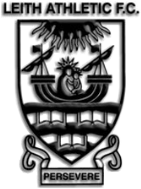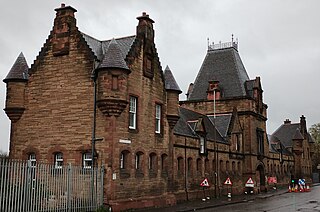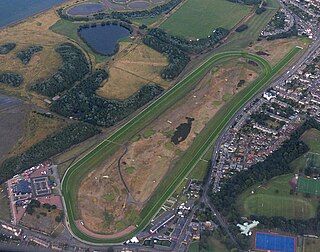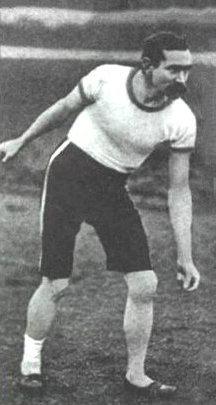
Henry Norwood "Barney" Ewell was an American athlete, and winner of one gold and two silver medals at the 1948 Summer Olympics.

Edinburgh City Football Club is a semi-professional senior Scottish football club which plays in Scottish League Two, the fourth tier of the Scottish Professional Football League. The club play at Meadowbank Stadium, returning to the rebuilt arena in 2022 after five years at Ainslie Park.

Leith Athletic Football Club is a football club based in the Leith area of Edinburgh, Scotland. They compete in the East of Scotland Football League, First Division. First team matches are played at Meadowbank Stadium.

Powderhall is an area lying between Broughton Road and Warriston Road in the north of Edinburgh, the Scottish capital. Until recently it was best known for Powderhall Stadium, a greyhound racing track, which has now closed. The stadium also played host to motorcycle speedway racing from 1977 to 1995, as home to the Edinburgh Monarchs, who have since relocated to Armadale. The Powderhall Sprint, first held in 1870, was a professional footrace with handicapping of the runners. It continues, since 1999, as the New Year Sprint and is now held at Musselburgh Racecourse.
The Edinburgh Marathon is an annual marathon event, governed by Scottish Athletics and run in Scotland over the traditional distance of 42.195 kilometres (26.219 mi). The first marathon event in Edinburgh was in 1982. Further marathons were held in Edinburgh in 1986 and 1999. Since 2003 the Edinburgh Marathon Festival has been held each year, usually in May. The current route begins in the city centre, moves out of Edinburgh into East Lothian, finishing at Musselburgh, East Lothian.

Musselburgh Racecourse is a horse racing venue located in the Millhill area of Musselburgh, East Lothian, Scotland, UK, close to the River Esk. It is the second biggest racecourse in Scotland and is the fourteenth biggest in the UK. In 2016, Musselburgh staged 28 fixtures. It was officially known as "Edinburgh Racecourse", and referred to as such in the English press, until the beginning of 1996 but was widely referred to as "Musselburgh" in Scotland long before that and was widely referred to as Musselburgh in the racing pages of Scottish newspapers.

The Edinburgh Monarchs are a Scottish speedway team based in Armadale. They compete in the SGB Championship, racing on Friday nights during the speedway season. The club is run by a board of directors, chaired by Alex Harkess and also runs a National Development League team called the Monarchs Academy.
Dayjur was an American-bred, British-trained Thoroughbred racehorse. A specialist sprinter, he ran eleven times between June 1989 and October 1990 and won seven races. In 1990 he dominated European sprinting, winning the King's Stand Stakes, the Nunthorpe Stakes, the Ladbroke Sprint Cup and the Prix de l'Abbaye. On his final racecourse appearance he finished second to Safely Kept in the Breeders' Cup Sprint. The Racing Post called him "the world's fastest horse".

Frederick Charles "Tenby" Davies was a Welsh athlete who became the half-mile world professional champion in 1909 after a race against Irishman Beauchamp Day.
Jim Bradley was a professional athletics coach, renowned for his innovative use of speedball for an athlete's general preparation. Bradley is the only coach to have trained multiple winners of the four best known & most prestigious professional footraces in the world: the New Year Sprint (Scotland) 5 winners, the Stawell Gift (Australia) 2, the Bay Sheffield (Aust) 3 & the Burnie Gift (Aust) 2.
George McNeill is a Scottish former world professional sprint champion and the only man to have won both of the most famous professional footraces in the world – the New Year Sprint (1970) in Scotland and the Australian equivalent – the Stawell Gift (1981). McNeill had previously played professional football in the Scottish Football League for Hibernian, Greenock Morton and Stirling Albion.

Powderhall Stadium, formerly the Powderhall Grounds, was a multi-sports facility overlooking the Water of Leith on Beaverhall Road, in the Powderhall (Broughton) area of northern Edinburgh, Scotland. It opened in January 1870 at the height of professional pedestrianism and was modelled on the stadium at Stamford Bridge in London. It hosted professional sprint races, track and field athletics, including the Scottish Amateur Athletics Championships on a number of occasions, professional football, international rugby, cycling, and dog races as well as boxing, quoits and pigeon shooting. For 100 years it hosted the Powderhall Sprint, the most famous professional sprint handicap in the world. With the decline of pedestrianism as a spectator sport in the 1920s it was converted to a greyhound stadium, hosting the Scottish Grand National for over sixty five years, and it also hosted professional speedway. The stadium finally closed in 1995 and the site is now a housing estate.
Pall Mall (1955–1978) was an Irish-bred, British-trained Thoroughbred racehorse and sire, best known for winning the classic 2000 Guineas in 1958. Owned and bred by Queen Elizabeth II, Pall Mall was one of the leading British two-year-olds of 1957, when he won the New Stakes at Royal Ascot and was placed in three other important races. In the following spring, he performed moderately in two trial races before creating a 20/1 upset by winning the 2000 Guineas. He later won the first two runnings of the Lockinge Stakes before being retired to stud, where he had some success as a sire of winners.
Les Arcs was a Thoroughbred racehorse who was bred in the United States and trained in the United Kingdom. After racing with mixed results over a variety of distances, the gelding emerged as a top-class performer when switched to sprint distances. In 2006 he won six races including the Golden Jubilee Stakes and the July Cup, both Group One races and was the highest-rated European sprinter of the year. He was also named Horse of the Year by the Maryland Horse Breeders Association. In all, Les Arcs won twelve races and was placed ten times from forty-two starts between May 2003 and August 2010.
Homing was a British Thoroughbred racehorse and sire. Although he never won at Group One race, he established himself as the leading horse in Europe over one mile in 1978. His early form was moderate, but in the autumn of his three-year-old season he made dramatic improvement to record wide margin victories in the Prix du Rond Point and the Queen Elizabeth II Stakes. He was retired from racing at the end of the season, having won six of his fourteen races, and had modest success as a breeding stallion.

Harry Hutchens was a professional British runner. Hutchens became a messenger at Putney railway station at 14 and soon discovered he was a fast runner. He became a professional in 1876. Hutchens died poor and in obscurity in 1939 but received an obituary from The New York Times.
Bay Express was an Irish-bred British-trained Thoroughbred racehorse and sire. A specialist sprinter, he showed some promise when winning one minor race as a two-year-old in 1973. In the following year he won all three of his races including the Temple Stakes and the King's Stand Stakes before his season was ended by injury. As a four-year-old in 1975 he established himself as the best British-trained sprinter of the year with an emphatic win in the Nunthorpe Stakes. He later had some success as a breeding stallion.
Fayr Jag was an Irish-bred, British-trained Thoroughbred racehorse. Trained throughout his racing career in Yorkshire by Tim Easterby he was a durable sprinter who ran 64 times and won eleven races in seven seasons between 2001 and 2007. After winning a minor race in each of his first two seasons he made his first major impact as a four-year-old by winning two handicap races before dead-heating for first place in the Wokingham Stakes at Royal Ascot. Later that year he was moved up in class and added victories in the Hopeful Stakes and the Ridgewood Pearl Stakes. In the following year he recorded his biggest win when he defeated a top-class field to win the Group One Golden Jubilee Stakes. He was then without a win for two years before returning to form to win the Chipchase Stakes and the Hackwood Stakes in 2006. Fayr Jag failed to win in 2007 and died after injuring himself in the starting stalls on what was intended to be his first race of 2008.

Mabs Cross is a British Thoroughbred racehorse. She did not compete as a two-year-old in 2017 and in the following year she ran mainly in minor sprint handicaps before being stepped up in class to win the Arran Scottish Fillies' Sprint Stakes on her final appearance of the season. In 2018 she made relentless improvement, winning the Palace House Stakes in spring and then being placed in the King's Stand Stakes and the Nunthorpe Stakes before recording her biggest success in the Prix de l'Abbaye. The highlight of her final campaign was a second win in the Palace House Stakes.
Alpha Delphini is a British Thoroughbred racehorse. A specialist sprinter, he was unraced as a juvenile and did not win a race until the August of his four-year-old campaign. In 2016 he made steady progress, winning three handicap races before taking the Listed Beverley Bullet Sprint Stakes. He won two minor races in 2017 and in the following year he recorded his biggest success when he won the Group 1 Nunthorpe Stakes. He failed to win in four subsequent races and was retired from racing in 2020.









